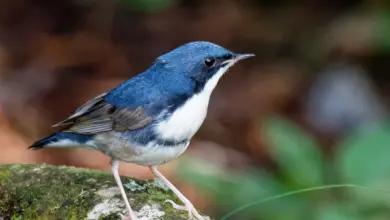Screech Owls (genus: Megascops)
The Screech Owls (genus: Megascops) are owls only found in the Americas, where they are mostly resident (non-migratory). All members of the genus are small and agile.
These nocturnal and solitary birds become active after sunset and silently hunt their prey at night.
Description
These small owls measure between 8 – 12 inches (20 – 30 cm) in length (including the short tail).
In North America, the Eastern Screech Owl is one of the smallest naturally occurring species of owl. The largest species of this genus is the White-throated Screech Owl.
Screech owls possess a facial disk and ear tufts; and the color of their plumage ranges from greyish to brownish with a concealing bark pattern.
There are considerable geographic variations – with the northern races being generally larger in size, but less heavily patterned than those occurring in the southern ranges.
Screech owls are generally colored in various brownish hues with usually a whitish, patterned underside, which helps to camouflage them against the bark of trees.
Some are polymorphic, occurring in a grayish- and a reddish-brown morph. The head is large and round, with prominent, wide-set ear (feather) tufts. The eyes range in color from greyish-yellow to bright yellow.
Interesting Tidbits:
- Screech Owls are the smallest owls found in North America.
- Tree Branch Mimic – Predator Evasion Techniques: During the day, these owls conceal themselves in trees, with their plumage camouflaging them well against the bark. When confronted by a slightly larger bird of prey (such as a barn owl), they will puff up their plumage to look larger and scare the potential predator away. However, if the opponent is significantly larger, the screech owls will make themselves look skinny (like a tree branch) by elongating the body and flattening their feathers. They will also squint their eyes and even sway back and forth to imitate the natural movements of a branch.
- Superstitions: Throughout history, owls have been the subject of a multitude of contradictory beliefs. They have been feared and hated by some cultures, and admired, loved and even worshipped by others; and many of these speculations began in earliest folklore, and were passed down by word of mouth over generations.
- As suggested by some of their common names (Spirit Owls, Whickering Owls, Demon and Death Owls), they were associated with the occult (i.e., witchcraft), medicine, birth and death. These superstitious beliefs were fueled by their nocturnal habits; their silent flight; the strange, haunting sounds they make; and their huge eyes.
- In some cultures, it was believed that owls were set loose from the spirit world to catch souls; that if you heard an owl in the middle of the day, someone you know would pass away (hence the name “Death Owl”). In English Folklore, many people believed that the screech or call of an Owl flying past the window of a sick person meant imminent death. The deaths of Julius Caesar, Augustus and Commodus Aurelius were said to have been predicted by owls. “Whickering Owls” on a property were said to be possessed by witches and were there to steal the souls of babies. According to Roman superstitions, witches transformed themselves into owls and sucked the blood of babies.
- In early Indian folklore, Owls represented wisdom and were said to have powers of prophecy.
- In the mythology of ancient Greece, these owls were considered protectors and accompanied Greek armies to war. It was considered a sign of victory, if an owl flew over Greek Soldiers before a battle.
- Silent Flight: Some superstitions with respect to this owl originated from its silent flight. The flight feathers of the screech owls are serrated at their tips, which muffles the noise they make as they flap their wings. This allows them to sneak up on their unsuspecting prey.
These owls have such an acute sense of hearing that they can even find mammals under heavy vegetation or snow.- Their large eyes and excellent eye sight are useful for picking up small movements at night.
- Their maximum lifespan is 20+ years; however, their average lifespan in the wild is only about 3 to 7 years. The mortality of nestlings and juveniles, in particular, is as high as 70% – mostly due to being hit by cars as they hunt in the night; or due to predation by cats, minks, weasels, raccoons, skunks, snakes, and other birds.
- They are preyed upon by larger owls, such as Great Horned Owls, Barred Owls, Great Grey Owls, Short-eared Owls, Snowy Owls; as well as hawks and crows. Blue Jays will go after the younger nestlings.
Habitat
Depending on the species, screech owls are typically found in mixed woodlands, deciduous red cedar, hemlock, Sitka spruce and Douglas fir forests, isolated groves, wooded swamps / wetlands (particularly in drier areas).
They are also commonly found in residential areas, orchards, parks and cemeteries with shade trees.
They typically avoid areas that are hunting grounds for the larger owls (particularly the Great Horned Owl).
During the day, they roost in natural cavities of large dead or living trees, in buildings or in the dense scrubby brush or foliage.
Subspecies
- Western Screech Owl, Megascops kennicottii
- Balsas Screech Owl, Megascops seductus
- Pacific Screech Owl, Megascops cooperi
- Eastern Screech Owl, Megascops asio
- Koepcke’s Screech Owl, Megascops koepckeae
- West Peruvian Screech Owl, Megascops roboratus
- Bare-shanked Screech Owl, Megascops clarkii
- Bearded Screech Owl, Megascops barbarus
- Rufescent Screech Owl, Megascops ingens
- Colombian Screech Owl, Megascops colombianus
- Cinnamon Screech Owl, Megascops petersoni
- Cloud-forest Screech Owl, Megascops marshalli
- Tawny-bellied Screech Owl, Megascops watsonii
- Middle American Screech Owl, Megascops guatemalae
- Chocó Screech Owl, Megascops centralis
- Foothill Screech Owl, Megascops roraimae
- Roraiman Screech Owl, Megascops (roraimae) roraimae
- Rio Napo Screech Owl, Megascops (roraimae) napensis
- Yungas Screech Owl, Megascops hoyi
- Black-capped Screech Owl, Megascops atricapilla
- Long-tufted Screech Owl, Megascops sanctaecatarinae ((construed with the name argentinus))
- Puerto Rican Screech Owl, Megascops nudipes
- Virgin Islands Screech Owl, Megascops nudipes newtoni – extinct (1860s)
- Whiskered Screech Owl, Megascops trichopsis
- Tropical Screech Owl, Megascops choliba
- White-throated Screech Owl, Megascops albogularis
Diet / Feeding
Screech Owls mostly feed on larger insects, such as beetles, moths, crickets, grasshoppers and cicadas, which makes up more than half of their diet. They will also hunt small mammals, such as rodents, bats, shrews up to the size of rabbits; and birds ranging from chickadees, sparrows, warblers up to the size of a Ruffed Grouse (which are heavier than screech owls).
On occasion, they will also take earthworms, reptiles (small snakes, lizards even baby soft-shelled turtles), amphibians (frogs, toads, etc.) and small fish.
Most hunting is being done during the first hours of darkness. They use their excellent hearing and night vision to locate prey. They usually watch from a perch and swoop down when prey is spotted and seize their prey with their well-developed raptorial claws (talons).
They are also capable of catching insects or small birds in flight.
During the winter, they have been observed hunting for fish at fishing holes or cracks in ice at bodies of water.
Smaller prey is usually swallowed whole on the spot; while larger prey is typically carried to the nests or roosting place where they use their claws and the curved bill to tear the prey into pieces that are small enough for them to swallow.
Every day, they expel about 2 – 4 medium-sized, compact, dark grey, oval pellets that are about 1.5 – 0.75 inches (3.8 – 1.9 cm) in diameter. These pellets are composed of indigestible parts of its prey – such as fur, feathers, bones, teeth and chitin.
Nesting / Breeding
The breeding season usually starts in early spring.
The males select the nest sites, and the females selects their mates based on the quality of the nest site or the amount of food the male placed into the nest.
As part of an elaborate courtship ritual, males approach females, calling from different branches until they are close; at which point the males bobs and swivels his head, and then bobs his entire body. If the female ignored him, he intensifies his bobbing and swiveling. If she is receptive, she will move closer, their bills touch and they start preening each other.
Pairs are monogamous, mating for life; however, they will accept a new mate if their previous mate disappears.
Males will defend small territories around their nest sites.
Screech owls typically nest in cavities of deciduous trees, such as oaks and maples. These cavities are typically 6.5 – 20 feet (2 – 6 meters) above the ground, but may be situated as high as 50 feet (15 meters) above the ground. They may use the abandoned nests of other birds, such as woodpeckers.
In urban areas, they may also use suitable nest boxes or nest behind loose boards on abandoned buildings or barns.
They typically reuse the same nesting site year after year.
The average clutch consists of 3 – 4 eggs. The female does most of the incubation (brooding of the eggs) which lasts about 26 days to hatching.
The male is responsible for feeding the nesting female. Once the young hatched, the female will tear food up into smaller sizes to feed to the young.
Due to nest predation, only one young is likely to survive to fledging, which occurs about 31 days after hatching.
They usually only produce one clutch a season; but may produce a second, if the first clutch is lost.
Calls / Vocalizations
Notwithstanding name, Screech Owls rarely screech; their calls – depending on the subspecies – are:
- a series of short whistles “hoo-hoo-hoo….”at an increasing tempo or a short then long trill while maintaining a constant pitch;
- barking and chuckling sounds;
- tooting “bouncing ball” songs;
- plaintive, mellow trills that descend in tone and have a whinny-like quality
- highpitched screech calls.
During the day, these owls are rarely seen due to their nocturnal habitats – however, their haunting calls are often indicative of their presence.
More Owl Information
- Owl Information
- Index of Owl Species with Pictures
- Owl Eyes / Vision Adaptations
- Pygmy Owls
- Barn Owls
- Horned Owls
- Scops Owls
Beauty Of Birds strives to maintain accurate and up-to-date information; however, mistakes do happen. If you would like to correct or update any of the information, please contact us. THANK YOU!!!




